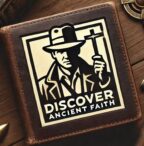Rediscovering the Original Christian Church
We live in an age of religious confusion.
There are thousands of Christian denominations, each interpreting Scripture in its own way. Today, the word “church” can refer to anything—from a stadium filled with lights and music, to a quiet living room meeting with no structure at all.
But what is the Church, really?
What did the early Christians believe?
How did they worship?
And what kind of lives did they live?
Why the First Christians Matter
Nearly every Christian agrees on one thing:
The Church of the Apostles was right.
Its worship, structure, and teachings were rooted in the people who walked with Christ Himself. But over time, many believe, the Church changed—shaped by culture, corrupted by power, or divided by politics.
If that’s true, then the earliest years—the first 250 years of Christianity—are our clearest window into what the Church was meant to be.
A Call to Start Fresh
To find the ancient Christian faith, we need to step away from modern assumptions.
Let’s pause what we’ve heard from:
- TV preachers
- Internet personalities
- Well-meaning pastors
- Even family and friends
Not because they are necessarily wrong—but because even good intentions can pass on filtered or biased information.
If we want to find the original Christian Church, we have to go back to the sources.
What We’ll Explore in This Series
This is a serious investigation—not into denominational claims, but into historical truth. Here’s how we’ll approach it:
1. Scripture
Especially:
- The Book of Acts
- Hebrews
- The Letters to Timothy
These books offer direct insight into how the early Church functioned, how leaders were chosen, and how communities lived and worshipped together.
2. Writings of the Early Church Fathers
We’ll read voices from just after the Apostles—men who learned directly from them:
- Clement of Rome
- Ignatius of Antioch
- Polycarp
- Justin Martyr
- Others who wrote, led, and in many cases, died for their faith
3. Non-Christian Sources
To avoid internal bias, we’ll examine how early Christians were described by:
- Roman officials
- Pagan philosophers
- Early critics who saw their worship firsthand
4. Contemporary Historical Texts
We’ll study what life was like in the Roman Empire during those years:
- What laws and customs shaped Christian life?
- What was the cost of being a believer?
5. Archaeological Evidence
We’ll explore:
- Early house churches
- Christian symbols and tombs
- Graffiti, inscriptions, and ruins
These help us see what early Christian worship actually looked like in practice—not just in theory.
Why I’m Writing This
I’m not a theologian. I’m not here to push an agenda.
My background is eclectic.
I was raised part-time Mormon, part-time evangelical Protestant—the result of growing up in a broken home.
My education is in science and business, not theology.
So I’m approaching this like anyone else might: confused, curious, and trying to make sense of what’s true.
I’m asking the same questions you might be:
- “What did the first Christians believe?”
- “How did they worship?”
- “What was the original Christian Church like?”
- “And where can I find that Church today?”
Let’s find out together.
Let the early voices speak.
Let the Scriptures speak.
Let history and archaeology speak.
Let the journey begin.

